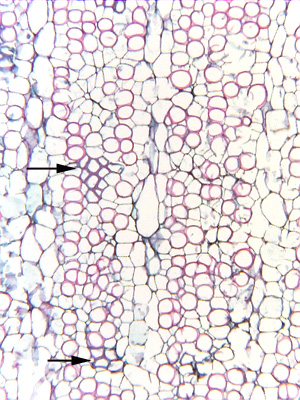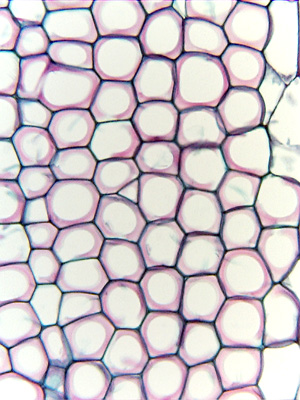 Fig.
15.4-2a and b. Transverse sections of dimorphic
cactus wood (Bishop’s cap cactus, Astrophytum ornatum). This
cactus grows initially as a short, fat globose plant, with such a wide cortex
that turgor pressure alone supports the plant. At that time, it makes wood like
that in the lower figure: wood
consisting of vessels and wide–band tracheids. Such wood is so soft
and spongy that if there is a prolonged drought, the cactus—wood and all—can
just shrink down to a smaller volume. When rain returns, the plant and its wood
can swell and enlarge.
Fig.
15.4-2a and b. Transverse sections of dimorphic
cactus wood (Bishop’s cap cactus, Astrophytum ornatum). This
cactus grows initially as a short, fat globose plant, with such a wide cortex
that turgor pressure alone supports the plant. At that time, it makes wood like
that in the lower figure: wood
consisting of vessels and wide–band tracheids. Such wood is so soft
and spongy that if there is a prolonged drought, the cactus—wood and all—can
just shrink down to a smaller volume. When rain returns, the plant and its wood
can swell and enlarge.
 micrograph:
it is mostly vessels in a
matrix of parenchyma, but some nests of fibers (arrows) are present,
and presumably if the plant became older and heavier, it would ultimately
produce wood with many fibers. Both micrographs are of wood in the same
transverse section of the plant: the wide-band tracheid wood occurs near the
pith, the parenchymatous/fibrous wood is nearer the vascular cambium.
micrograph:
it is mostly vessels in a
matrix of parenchyma, but some nests of fibers (arrows) are present,
and presumably if the plant became older and heavier, it would ultimately
produce wood with many fibers. Both micrographs are of wood in the same
transverse section of the plant: the wide-band tracheid wood occurs near the
pith, the parenchymatous/fibrous wood is nearer the vascular cambium.